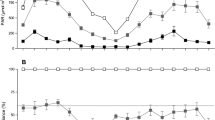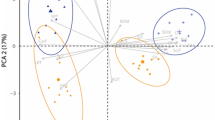Abstract
The ecophysiological traits of seven spring forest geophytes (Gagea lutea L., Scilla bifolia L., Ficaria verna L., Corydalis cava (L.) Koerte, Arum maculatum L., Dentaria bulbifera L. Crantz, and Ornithogalum pyrenaicum L.) were compared in terms of photosynthetic performance, chlorophyll content, specific leaf area, and relative water content from early spring to summer under field conditions. Light response curves were measured for each species throughout the continuum of its phenological phases to quantify the photosynthetic photon flux density at light saturation, light-saturated photosynthetic rate and light compensation point. All species showed similar seasonal dynamics of the assessed parameters, but the average seasonal values of photosynthesis, dark respiration and maximum efficiency of the photosystem II, as well as light saturation point and light compensation point, differed significantly. From the ecophysiological parameters that were determined it appears that the investigated species can be grouped in two categories: ‘early-flowering’ spring ephemerals (higher P N, I comp, I sat, R d, lower F v/F m, more shade-avoiding strategy): G. lutea, S. bifolia, F. verna, C. cava and ‘later-flowering’ spring ephemerals (lower P N, I comp, I sat, R d, higher F v/F m, more shade-tolerating strategy): A. maculatum, D. bulbifera, and O. pyrenaicum.



Similar content being viewed by others
References
Anderson WB, Eickmeier WG (2000) Nutrient resorption in Claytonia virginica L.: implication for deciduous forest nutrient cycling. Can J Bot 78:832–839
Arnon DI (1949) Copper enzymes in isolated chloroplasts. Polyphenoloxidase in Beta vulgaris. Plant Physiol 24:1–15
Badri MA, Minchin PEH, Lapointe L (2007) Effects of temperature on the growth of spring ephemerals: Crocus vernus. Physiol Plantarum 130:67–76
Barrs HD, Weatherley PE (1962) A re-examination of the relative turgidity technique for estimating water deficit in leaves. Aust J Biol Sci 15:413–428
Bernatchez A, Lapointe L (2012) Cooler temperatures favour growth of wild leek (Allium tricoccum), a deciduous forest spring ephemeral. Botany 90:1125–1132
Bjorkman O, Demming-Adams B (1995) Regulation of photosynthetic light energy capture, conversion and dissipation in leaves of higher plants. In: Shulze ED, Caldwell MM (eds) Ecophysiology of plants. Springer-Verlag Springer, Berlin, pp 17–47
Bond BJ (2000) Leaf-age related changes in photosynthesis of woody plants. Trends Plant Sci 5:349–353
Bratton SP (1976) Resource divisin in an understory herb community: response to temporal and microtophographic gradients. Am Nat 110:679–693
Brown RL, Ashmun JW, Pitelka LF (1985) Within- and between-species variation in vegetative phenology in two forest herbs. Ecology 66:251–258
Byerzichudek P (1982) Life histories and demography of shade-tolerant temperate forest herbs: a review. New Phytol 90:757–776
Chen L, Tam NFY, Huang J, Zeng X, Meng X, Zhong C, Wong Y-S, Lin G (2008) Comparison of ecophysiological characteristics between introduced and indigenous mangrove species in China. Estuar Coast Shelf Sci 79:644–652
Constable JVH, Peffer BJ, DeNicola DM (2007) Temporal and light-based changes in carbon uptake and storage in the spring ephemeral Podophyllum peltatum (Berberidaceae). Environ Exp Bot 60:112–120
Cornelissen JHC, Lavorel S, Garnier E, Diaz S, Buchmann N, Gurvich DE, Reich PB, terSteege H, Morgan HD, van der Heijden MGA, Pausas JG, Poorter H (2003) A handbook of protocols for standardised and easy measurement of plant functional traits worldwide. Aust J Bot 51:335–380
Dahlgren JP, Eriksson O, Bolmgren K, Strindell M, Ehrlen J (2006) Specific leaf area as a superior predictor of changes in field layer abundance during forest succession. J Veg Sci 17:577–582
Demmig-Adams B, Adams WW III (2006) Photoprotection in an ecological context: the remarkable complexity of thermal energy dissipation. New Phytol 172:11–21
Domingues TF, Martinelli LA, Ehleringer JR (2007) Ecophysiological traits of plant functional groups in forest and pasture ecosystems from eastern Amanonia, Brazil. Plant Ecol 193:101–112
Đurđević L, Popović Z, Mitrović M, Pavlović P, Jarić S, Lj Oberan, Gajić G (2008) Dynamics of bioavailable soil phenolics and photosynthesis of Arum maculatum L. in a lime-beech forest. Flora 203:590–601
Eickmeier WG, Schussler EE (1993) Responses of the spring ephemeral Claytonia virginica to light and nutrient manipulations and implications for the “vernal-dam” hypothesis. Bull Torrey Bot Club 120:157–165
Elemans M (2002) Plant traits in forest understory—a modeling study. Dissertation, Utrecht University, Utrecht
Endler JA (1993) The color of light in forests and its implications. Ecol Monographs 63:1–27
Farrar JF (1996) Sinks—integral parts of a whole-plant. J Exp Bot 47:1273–1279
Fichtner K, Koch GW, Mooney HA (1995) Photosynthesis, storage, and allocation. In: Schulze ED, Caldwell MM (eds) Ecophysiology of photosynthesis. Springer, Berlin, pp 133–146
Field CB (1981) Leaf age effects on the carbon gain of individual leaves in relation to microsite. In: Margaris NS, Mooney HA (eds) Components of productivity of mediterranean-climate regions: basic and applied aspects. Junk, The Hague, pp 41–50
Field CB, Mooney HA (1983) Leaf age and seasonal effects on light, water, and nitrogen use efficiency in a California shrub. Oecologia 56:348–355
Fitter AH, Hay RK (2002) Environmental physiology of plants. Academic Press, San Diego
Gilliam F, Roberts M (2003) The Herbaceous layer in forests of eastern North America. Oxford University Press, Oxford
Gorishina TK (1969) Ranavesenie efemeroidi lesostepnih dubrav. Leningrad
Gutjahr S, Lapointe L (2008) Carbon dioxide enrichment does not reduce leaf longevity of alter accumulation of carbon reserves in the woodland spring ephemeral Erythronium americanum. Ann Bot 102:835–843
Hiscox JD, Israelstam GF (1979) A method for the extraction of chlorophyll from leaf tissue without maceration. Can J Bot 57:1332–1334
Hull JC (2002) Photosynthetic induction dynamics to sunflecks of four deciduous forest understory herbs with different phenologies. Int J Plant Sci 163:913–924
Ida TY, Kudo G (2008) Timing of canopy closure influences carbon translocation and seed production of an understorey herb Trillium apetalon (Trilliaceae). Ann Bot 101:435–446
Ishioka R, Muller O, Hiura T, Kudo G (2013) Responses of leafing phenology and photosynthesis to soil warming in forest-floor plants. Acta Oecol 51:34–41
Karadžić B, Popović R, Jovanović Z, Mijović A (1999) RGRP, a database and software for computing relative growth rate of plants. Arch Biol Sci 51:195–204
Lapointe L (2001) How phenology influences physiology in deciduous forest spring ephemerals. Physiol Plantarum 113:151–157
Larcher W (1995) Physiological plant ecology. Springer, Berlin
Lűttge U, Scarano FB (2007) Synecological comparisons sustained by ecophysiological fingerprinting of intrinsic photosynthetic capacity of plants as assessed by measurements of light response curves. Braz J Bot 30:355–364
Mamushina NS, Zubkova EK (1996) Effect of temperature on potential photosynthesis and photosynthetic carbon metabolism in C3 plants with different seasonal patterns of development. Rus J Plant Physiol 43:313–318
Mamushina NS, Voznesenskaya EV, Zubkova EK, Maslova TG, Miroslavov EA (2002) Structural and functional changes of mesophyll cells during leaf growth in two species of spring ephemers. Rus J Plant Physiol 49:194–202
Masarovičova E, Eliaš P (1980) Chlorophyll content in leaves of plants in an Oak-Hornbeam forest 1: Herbaceous species. Photosynthetica 14:580–588
Masarovičova E, Eliaš P (1986) Photosynthetic rate and water relations in some forest herbs in spring and summer. Photosynthetica 20:187–195
Maslova TG, Mamushina NS, Zubkova EK, Voitsekhovskaya OV (2003) Specific features of plastid pigment apparatus and photosynthesis in the leaves of ephemeroid and summer plants as related to photoinhibion. Rus J Plant Physiol 50:52–56
Michell PL, Woodward FI (1988) Responses of three woodland herbs to reduced photosynthetically active radiation and low red to far-red ratio in shade. J Ecol 76:807–825
Myers CV, Anderson RC (2003) Seasonal variation in photosynthetic rates influences success of an invasive plant, garlic mustard (Alliaria petiolata). Am Midl Nat 150:231–245
Nault A, Gagnon D (1993) Seasonal biomass and nutrient allocation patterns in wild leek (Allium tricoccum Ait), a spring geophyte. Bull Torrey Bot Club 115:45–54
Oquist G, Wass R (1988) A portable, microprocessor operated instrument for measuring chlorophyll fluorescence kinetics in stress physiology. Physiol Plantarum 73:211–217
Parsons RF (2000) Monocotyledonous geophytes: comparison of California with Victoria, Australia. Aust J Bot 51:39–43
Popović Z, Mijović A, Karadžić B (2005) Dry matter distribution patterns and photosynthetic traits of two vernal ephemeroids in a deciduous forest. Period Biol 107:287–292
Popović Z, Mijović A, Karadžić B, Mijatović M (2006) Response of growth dynamics to light regime of two spring geophytes in a lime-beech forest. J Integr Plant Biol 48:527–535
Powels SB (1984) Photoinhibition of photosynthesis induced by visible light. Annu Rev Plant Physiol 35:15–44
Raunkiaer C (1934) The life forms of plants. Clarendon Press, Oxford
Republic Hydrometeorological Service of Serbia (2012) Republic Hydrometeorological Annual Report. The Service, Belgrade
Ribeiro RV, Souza GM, Oliveira RF, Machado EC (2005) Photosynthetic responses of tropical tree species from different successional groups under contrasting irradiance conditions. Braz J Bot 28:149–161
Rogers RS (1982) Early spring herb communities in mesophytic forests of the Great Lakes region. Ecology 63:1050–1063
Rothstein D, Zak D (2001) Photosynthetic adaptation and acclimation to exploit seasonal periods of direct irradiance in three temperate, deciduous-forest herbs. Funct Ecol 15:722–731
Sawada S, Harada A, Asari Y, Asano S, Kuninaka M, Kawamura J, Kasai M (1999) Effects of micro-environmental factors on photosynthetic CO2 uptake and carbon fixation metabolism in a spring ephemeral, Erythronium japonicum, growing in native and open habitats. Ecol Res 14:119–130
Schemske DW, Willson MF, Melampy MN, Miller LJ, Verner L, Shemske KM, Best LB (1978) Flowering ecology of some spring woodland herbs. Ecology 59:351–366
Schulze ED (1982) Plant life forms and their carbon, water and nutrient relations. In: Lange OL, Nobel PS, Osmond CB, Ziegler H (eds) Encyclopedia of plant physiology 12B. Springer, Berlin, pp 181–230
Smith TM, Shugart HH, Woodward FI (1997) Plant functional types: their relevance to ecosystem properties and global change. Cambridge University Press, Cambridge
Sparling JH (1967) Assimilation rates of some woodland herbs in Ontario. Bot Gaz 128:160–168
Sunmonu N, Ida TY, Kudo G (2013) Photosynthetic compensation by the reproductive structures in the spring ephemeral Gagea lutea. Plant Ecol 214:175–188
Taylor RJ, Pearcy RW (1976) Seasonal patterns of the CO2 exchange characteristics of understory plants from a deciduous forest. Can J Bot 54:1094–1103
Terashima I, Hirosaka K (1995) Comparative ecophysiology of leaf and canopy photosynthesis. Plant Cell Environ 18:1111–1128
Tessier JT, Raynal DJ (2003) Vernal nitrogen and phosphorous retention by forest understory and soil microbes. Plant Soil 256:443–453
Usuda H, Shimogawara K (1998) The effects of increased atmospheric carbon dioxide on growth, carbohydrates, and photosynthesis in radish, Raphanus sativus L. Plant Cell Physiol 39:1–7
Vezina PE, Grandtner MM (1965) Phenological observations of spring geophytes in Quebec. Ecology 46:869–872
Whigham DF (2004) Ecology of woodland herbs in temperate deciduous forests. Annu Rev Ecol Evol Syst 35:583–621
Wilson PJ, Thompson K, Hodgson JG (1999) Specific leaf area and leaf dry matter content as alternative predictors of plant strategies. New Phytol 143:155–162
Wyka TP, Oleksyn J, Žytowiak R, Karolewski P, Jagodziński AM, Reich PB (2012) Responses of leaf structure and photosynthetic properties to intra-canopy light gradient: a common garden test with four broadleaf deciduous angiosperm and seven conifer tree species. Oecologia 170:11–24
Yoshie F, Fukuda T (1994) Effects of growth temperature and winter duration on leaf phenology of Erythronium japonicum, a forest spring geophyte. Oecologia 97:366–368
Zubkova EK, Mamushina NS, Voitsekhovskaya OV, Filippova LA (1997) Respiratory metabolism of monocot ephemers under photosynthetic conditions in light. Rus J Plant Physiol 44:158–165
Acknowledgments
This work was supported by the Ministry of Education, Science and Technology of Serbia, Grant 173011. We thank four anonymous reviewers for helpful comments on earlier version of the manuscript.
Author information
Authors and Affiliations
Corresponding author
Rights and permissions
About this article
Cite this article
Popović, Z., Bojović, S., Matić, R. et al. Comparative ecophysiology of seven spring geophytes from an oak-hornbeam forest. Braz. J. Bot 39, 29–40 (2016). https://doi.org/10.1007/s40415-015-0204-4
Received:
Accepted:
Published:
Issue Date:
DOI: https://doi.org/10.1007/s40415-015-0204-4




